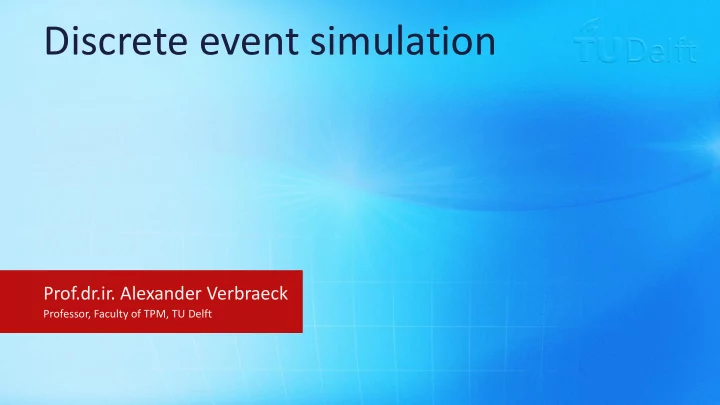

Discrete event simulation Prof.dr.ir. Alexander Verbraeck Professor, Faculty of TPM, TU Delft
Overview What is discrete event simulation? Where does it fit historically? How does it differ from other types of simulation? What are the steps in a simulation study? What are the important aspects of simulation for infrastructure studies? Summary
Simulation Simulation is: [Shannon, 1975] a process of designing a model of a concrete system and conducting experiments with this model in order to understand the behavior of a concrete system and/or to evaluate various strategies for the operation of the system
Simulation Simulation is: [Shannon, 1975] a process of designing a model of a concrete system and conducting experiments with this model in order to understand the behavior of a concrete system and/or to evaluate various strategies for the operation of the system What-if: parameters → output
Why discrete simulation? Instrument to: evaluate a systems design compare alternative solutions predict systems performance Mainly used for logistical problems: expected use of limited capacity or resources In some cases more advanced use: sensitivity analysis optimization
Systems thinking systems engineering engineering policy analysis systems analysis operations research mathematics soft systems methodology engineering/electronics cybernetics system dynamics control theory complex systems cas general systems theory biology 1930 world war II 1950 1960 1970 1980 1990 Slide courtesy Els van Daalen, TU Delft
Systems thinking systems engineering engineering discrete event simulation policy analysis systems analysis operations research mathematics soft systems methodology engineering/electronics cybernetics system dynamics control theory complex systems SD modeling cas general systems theory biology agent based modeling 1930 world war II 1950 1960 1970 1980 1990 Slide courtesy Els van Daalen, TU Delft
Similarities and differences Models are used to study the relationships between variables Simulation models study the evolution of variables over time The values of the model variables at a given time is called the state of the model In discrete-event simulation models, state changes occur at an instant of time An event is a change in model state, occurring at an instant Nance, 1981
Similarities and differences In continuous models, state is a continuous function of time: 160 140 120 100 80 60 40 20 0 1 11 21 31 41 51 61 71 81 91
Similarities and differences In discrete-event models, state is a piecewise constant function over time: 160 140 120 100 80 60 40 20 0 0 10 20 30 40 50 60 70 80 90 100
Discrete changes over time Very useful for: Queuing systems Resource usage Transportation Logistics and warehousing Control systems etc. For all these systems it means that we have to focus on the events , i.e. the start and the end of processes rather than the evolution of the process itself
Simulation model lifecycle diagnose problem validation model current problem identification “as is” situation and specification search for pre- post- evaluation solutions evaluation new models choice and “to be” situation implementation evaluation
Steps in a simulation study Conceptualization Demarcation Specification Reduction Data gathering Model building Verification and validation Experimentation Analysis Alternative generation Model adaptation Conclusions and reporting
Simulation project plan Traditional: waterfall model or iterative modeling But better: incremental modeling Conceptua- lisation Specification Data- collection Verification/ ... Validation
Simulation project plan Traditional: waterfall model or iterative modeling But better: incremental modeling ... Conceptua- Specification Data- Verification/ Treatment lisation collection validation
Simulation project plan Traditional: waterfall model or iterative modeling But better: incremental modeling Experimentation Analysis Diagnosis Treatment Conceptua- lisation Verification / Validation Data- Specifi- collection cation Start small...
Conceptualisation Output : a number of conceptual models that can be used to describe the system Demarcation of the system Language by which the system can be described: object based (object model) process based (process model) time based (event list)
Conceptualisation ActiveInfra Object model SingleInfra Straight Curve Storage Station LoadingStation UnloadingStation EntryStation ControlStation Lateral CV_TTUnloadingStation CV_DVCUnloadingStation CompoundInfra TwoWayBranch TwoWayJunction EarlyBagageBelt Helix Caroussel CheckIN
Conceptualisation Process model
Specification Output : working model that can be experimented with Reduction of the model Specification of model Detailed input/output specification Data gathering Build simulation model
Data for discrete simulation Data for: generators of items process durations in the model resource availability How to gather data: historical sources expert opinions measurements analogous systems
Verification/validation Output : simulation model that is correct and is a good representation of the real system Verification (correct representation of conceptual model) Validation (models represents reality): structural : testing of hypotheses on the model operational : compare values to real system values expert : analysis of the model by experts
Verification/validation Sargent, R.G. (2009). VERIFICATION AND VALIDATION OF SIMULATION MODELS. In: M. D. Rossetti, et al. (Eds.) Proceedings of the 2009 Winter Simulation Conference , IEEE, 2009, pp. 162 - 176.
Experiment specification Output : the run control conditions under which the system, or the model of it, is experimented with or observed Number of runs Run length Start-up time Values of input parameters Output parameters to be calculated
Analysis and diagnosis Output : results of analysis and diagnosis of the experiments with the model of the current situation Comparing alternatives Statistical analysis Current bottlenecks (long queues, idle resources, etc.) Sensitivity analysis for stability of results
Analysis and diagnosis Statistical analysis
Infrastructure simulation Replicate system components 1:1 as simulation model components Use of hierarchy to build a model "bottom-up" Libraries of components available in multiple simulation languages Infrastructure capacity and usage ↔ resource capacity and usage Animation can help in building, debugging and presenting All simulation libraries have components that gather many different statistics
Conclusions Discrete-event simulation: state change over time events piecewise constant state fast execution Model cycle: incremental building building blocks hierarchy, flow, process Data-intensive stochastic statistics for input and output
Thank you for your attention! Please post any questions you may have on our discussion forum
Recommend
More recommend